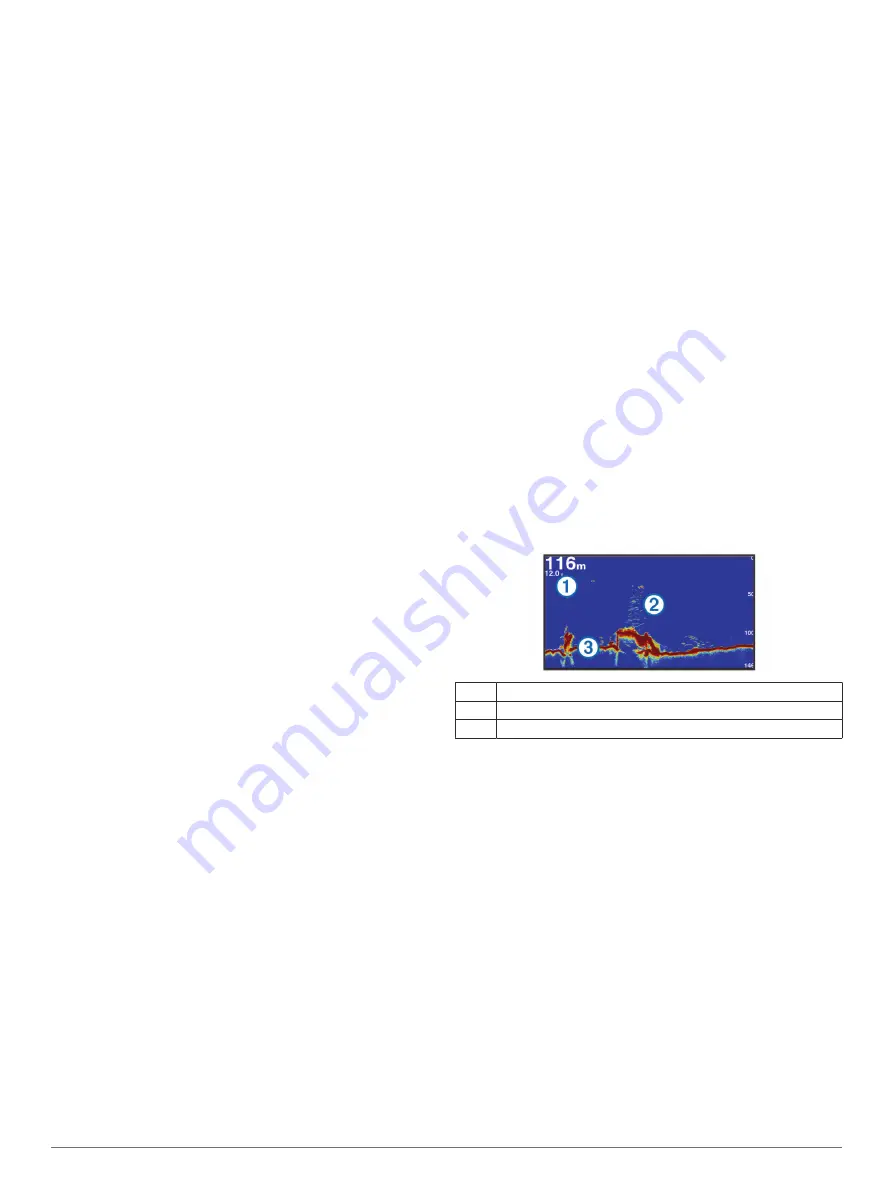
Setting a Tack and Gybe Delay
The tack and gybe delay allows you to delay steering a tack and
gybe after you initiate the maneuver.
1
From the autopilot screen, select
Menu
>
Autopilot Setup
>
Sailing Setup
>
Tack Delay
.
2
Select the length of the delay.
3
If necessary, select
Done
.
Enabling the Gybe Inhibitor
NOTE:
The gybe inhibitor does not prevent you from manually
performing a gybe using the helm or step steering.
The gybe inhibitor prevents the autopilot from performing a
gybe.
1
From the autopilot screen, select
Menu
>
Autopilot Setup
>
Sailing Setup
>
Gybe Inhibitor
.
2
Select
Enabled
.
Heading Line and Angle Markers
The heading line is an extension drawn on the map from the
bow of the boat in the direction of travel. Angle markers indicate
relative position from the heading or course over ground, which
are helpful for casting or finding reference points.
Setting the Heading and Course Over Ground Lines
You can show the heading line and the course over ground
(COG) line on the chart.
COG is your direction of movement. Heading is the direction the
bow of the boat is pointed, when a heading sensor is connected.
1
From a chart view, select
Menu
>
Chart Setup
>
Chart
Appearance
>
Heading Line
.
2
If necessary, select
Source
, and select an option:
• To automatically use the source available, select
Auto
.
• To use the GPS antenna heading for COG, select
GPS
Heading (COG)
.
• To use data from a connected heading sensor, select
North Reference
.
• To use data from both a connected heading sensor and
the GPS antenna, select
COG and Heading
.
This displays both the heading line and the COG line on
the chart.
3
Select
Display
, and select an option:
• Select
Distance
>
Distance
, and enter the length of the
line shown on the chart.
• Select
Time
>
Time
, and enter the time used to calculate
the distance your boat will travel in the specified time at
your present speed.
Turning on Angle Markers
You can add angle markers to the map along the heading line.
Angle markers can be helpful for casting when fishing.
1
Set the heading line (
Setting the Heading and Course Over
).
2
Select
Angle Markers
.
Sonar Fishfinder
When properly connected to a transducer, your compatible
chartplotter can be used as a fishfinder. Chartplotter models
without an xsv or xs in their names require a Garmin sounder
module and transducer to display sonar information.
For more information about which transducer is best for your
Different sonar views can help you view the fish in the area. The
sonar views available vary depending on the type of transducer
and sounder module connected to the chartplotter. For example,
you can view certain Panoptix sonar screens only if you have a
compatible Panoptix transducer connected.
There are four basic styles of sonar views available: a full-
screen view, a split-screen view that combines two or more
views, a split-zoom view, and a split-frequency view that
displays two different frequencies. You can customize the
settings for each view in the screen. For example, if you are
viewing the split-frequency view, you can separately adjust the
gain for each frequency.
If you do not see an arrangement of sonar views to suit your
needs, you can create a custom combination screen (
) or a SmartMode layout
(
).
Stopping the Transmission of Sonar Signals
From a sonar screen, select
Menu
>
Transmit
.
Changing the Sonar View
1
From a combination screen or SmartMode layout with sonar,
select the window to change.
2
Select
Menu
>
Change Sonar
.
3
Select a sonar view.
Traditional Sonar View
There are several full-screen views available, depending on the
equipment connected.
The full-screen Traditional sonar view show a large image of the
sonar readings from a transducer. The range scale along the
right side of the screen shows the depth of detected objects as
the screen scrolls from the right to the left.
À
Depth information
Á
Suspended targets or fish
Â
Bottom of the body of water
Split-Frequency Sonar View
In the split-frequency sonar view, one side of the screen shows
a full-view graph of high frequency sonar data, and the other
side of the screen shows a full-view graph of lower frequency
sonar data.
NOTE:
The split-frequency sonar view requires the use of a
dual-frequency transducer.
Split-Zoom Sonar View
The split-zoom sonar view shows a full-view graph of sonar
readings, and a magnified portion of that graph, on the same
screen.
Garmin ClearVü Sonar View
NOTE:
To receive Garmin ClearVü scanning sonar, you need a
compatible chartplotter or fishfinder and a compatible
transducer. For information about compatible transducers, go to
.
Garmin ClearVü high-frequency sonar provides a detailed
picture of the fishing environment around the boat in a detailed
representation of structures the boat is passing over.
Traditional transducers emit a conical beam. The Garmin
ClearVü scanning sonar technology emits two narrow beams,
similar to the shape of the beam in a copying machine. These
Sonar Fishfinder
19
Summary of Contents for GPSMAP 702 series
Page 1: ...GPSMAP 702 902SERIES Owner sManual...
Page 8: ......
Page 64: ...support garmin com April 2017 190 02141 00_0B...
Page 65: ...Quick Start Manual...
Page 76: ...2016 2017GarminLtd oritssubsidiaries VXSSRUW JDUPLQ FRP...






























